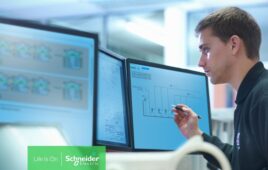
According to Persistence Market Research, the global smart machines market is expected to grow to $258.5 Billion by 2024, an 18.8% CAGR increase over 2016. Many end users purchase smart machines to avoid the legacy machine drawbacks of high maintenance costs and unpredictable downtime. High demand and exacting customer requirements pressure OEMs who build smart machines, challenging them to revamp their traditional operations to compete in this new digitized machines marketplace.
A critical component to unlocking the potential of these machines is the smart control system. In Industry 4.0, machine control systems now include Programmable Logic Controllers (PLCs) capable of real-time control and standardized integration into different architectures (OPC UA). Across Industrial Internet of Things (IIoT) environments, IIoT-native edge controllers collect data from connected devices and make it possible to analyze and monitor that data both on-premise and in the cloud in a safe and cybersecure manner.
OEMs can now stay one step ahead of their competitors by deploying controllers that demonstrate advanced connectivity, generate annuity revenue streams by enabling a new generation of digital services, and help end users unlock the power of big data.
3 factors that influence smart control system configurations
For OEM technical design leaders responsible for building and configuring smart machines and for OEM marketing and sales directors tasked with selling these machines, clear strategies for addressing multiple end-user smart machine scenarios are required.
Within digital manufacturing environments, these smart machines scenarios fall into three distinct buckets:
- Standalone small machines– These machines run in a standalone fashion on the plant floor and are not part of an integrated process. Their small footprint, reliability, cost-effectiveness, and quick startup make these machines highly desirable. An optimum configuration focuses on cost savings through easy programming and integration (without compromised performance) while implementing additional I/O for field components, including safety. The type of PLC selected is a critical component in addressing end user needs in this scenario. Some manufacturers, like Schneider Electric, offer online PLC-related tools that allow for easy selection and configuration, simple programming, and seamless repetitive machine production.
- Large machines with connectivity and remote management capabilities– This category typically performs numerous functions, may require multiple operators, and is often connected to various third-party devices on the plant floor. Such machines usually provide alarm management, access control, and data logging capabilities. These machines can also be connected to a network to enable remote monitoring and maintenance via Ethernet and provide historical and production information in addition to machine status. In such environments, flexible and scalable machine control is needed to easily upgrade higher performance platforms for improved efficiency as marketplace conditions change. The more powerful PLCs used in these machines should easily control devices such as motion & drives actuators, remote I/Os, and other decentralized elements.
- Large, complex, and multi-function machines for production lines– These complex machines usually consist of several multi-function line machines operating at high production speeds with reliable, easy diagnostics that enable quick response to changing production. They should be easy to engineer, flexible in design, simple to connect, and quick to integrate. Such machines are logic and motion-controlled, and IIoT-ready. A powerful new generation of PLCs (like the Schneider Electric Modicon M262) can control this series of connected machines as one large machine unit. Operators, production line managers, and maintenance personnel all interface with the machine and require powerful diagnostics and sophisticated remote monitoring capabilities. Machine flexibility, reliability, and safety are all key attributes in this environment.
For more information
When designing, building, installing, operating, maintaining, and supporting all three of these smart machine categories, partners like Schneider Electric can help OEMs account for both open standards and the demanding cybersecurity guidelines required. To learn more about how Schneider Electric can assist OEM technical design leaders and OEM marketing and sales managers in developing the skills necessary to compete in smart machine environments, download the e-guide “Machine Control for the Digital Age.”
Sponsored content by Schneider Electric
Filed Under: Schneider Electric Sponsored Content




